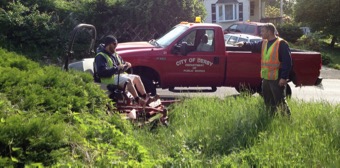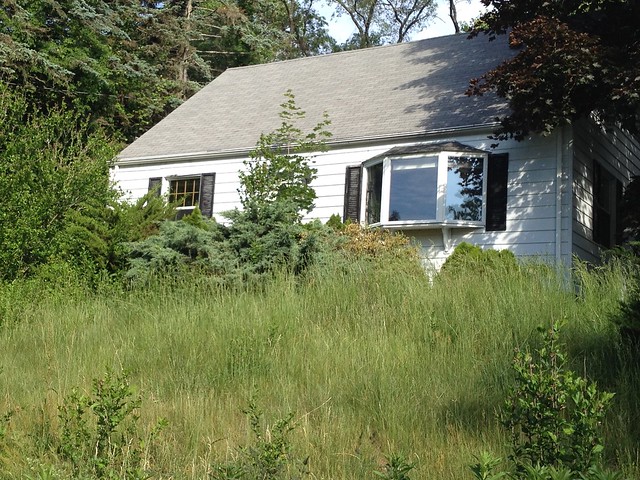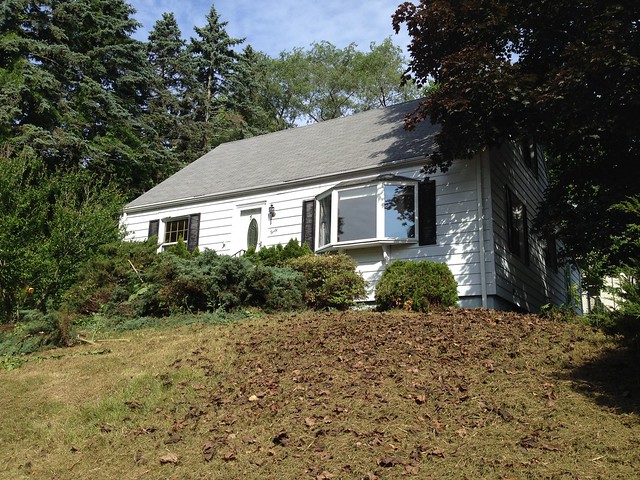 They came. They saw. They cut its grass.
They came. They saw. They cut its grass.
Armed with super-charged lawnmowers and more cutting tools than Edward Scissorhands, a crew from the Derby Department of Public Works went to work on a vacant property at 40 Marshall Lane Thursday.
It was the first property in Derby to get the business end of the city’s new “Clean and Lien” program.
What’s Clean and Lien?
Derby’s “Clean and Lien” program is local legislation targeting seriously overgrown yards at blighted properties.
Andrew Cota Sr., one of Derby’s two part-time facility inspectors (the guys on the front line of Derby’s blight battle) said the vegetation at 40 Marshall Lane — a highly visible property in east Derby — was encroaching on a neighbor’s property. Unchecked vines and branches have a way of growing into siding and roofs and doing major damage to vacant houses, Cota said.
The property has been on the blight list since 2014 and has piled up about $24,000 in blight fines. The previous owner and current owner haven’t return the city’s letters in ages. A file in the building department contains letters to the owners going back to 2013.
So, the “clean and lien” law allows the city or one of its agents to enter private property and do some maintenance — after notifying the property owner and giving he, she or it time to suggest another course of action.
Sounds like Derby’s a Communist state, you say?
Well, “clean and lien” started locally in Ansonia and officials there said they brought it to Ansonia because the law had already been defended it court.
Properties like the one at 40 Marshall Lane dot Derby and Ansonia like small cavities. They’re not just in what people label “bad” neighborhoods, but are found in the “hilltop” areas of both cities, too.
The house at 40 Marshall Lane, for example, last sold in 2006 for $269,000.
The properties annoy neighbors, bring down property values, and even attract vermin, officials said.
Here’s a photo of the property before workers arrived:
Here’s a photo after about 30 minutes of a Derby DPW attack:
The activities Thursday on Marshall Lane were limited to cutting the two-foot high grass, hauling away the clippings, chopping vines and out-of-control shrubs, and cleaning up trash. The DPW crew didn’t touch the 1,300 square-foot single family house. The house didn’t need their attention — and doing so would have gone beyond the scope of the local law.
Public works honcho Anthony DeFala will be putting together a bill detailing how much the city spent on 40 Marshall Lane. It’ll be at least $1,000.
The city will put a lien on the property with the hope of getting reimbursed if the property is sold.
History Not Important As Cleaning It Up
The history of the house at 40 Marshall Lane wasn’t clear. Officials said it’s been overgrown for at least five years and has a pending blight lien against it for about $24,000.
The previous owner may have been elderly and had to walk away from the property, city officials speculated.
However, there is no record of a foreclosure on the property in the state’s court database, yet the property is owned by a First Horizon Home Loan of Tennessee.
Regardless of the history, Third Ward Aldermen Carmen DiCenso said he often heard complaints from Derby residents about the property.
“It’s on a highly visible corner, Albert Avenue and Marshall Lane. You see how many cars drive by this intersection,” DiCenso said.
Here is a quick video from Thursday:
DiCenso, chairman of the Derby Board of Aldermen’s Blight Subcommittee, was on hand to observe the work Thursday.
A seven-person DPW crew began their work at 8:30 a.m. sharp. Within 15 minutes three people had stopped their vehicles on Marshall Lane to ask DiCenso what was happening. All three were happy to hear the property was getting some attention.
The DPW crew doing the work included foreman Mike Piscionieri, Dane DellaMonica, Gary Franco, Joe Tracz, Shawn Wheeler, Eric Roberts, Hunter Garofalo and later, Shawn Green.
DiCenso said having city workers do the job is cheaper than bringing in an outside contractor. The crew was expected to be there four hours or so.
The House
The 65-year-old house is a one-story cape with four bedrooms and one bathroom, according to assessor information. It’s on less than a half-acre of land.
The house looked like it was in decent shape, though a new roof would probably be on a buyer’s “to do” list. Peering through a window, one could see hardwood floors and a clean interior.
The fact that owner First Horizon Home Loan isn’t marketing the property is frustrating, both DiCenso and DeFala said.
“If you look in the window, the interior is beautiful. It’s been painted and the hardwood floors look great,” DiCenso said. “I just don’t understand why the banks don’t try to sell these properties. And then they don’t send anyone to do upkeep. They’re just discarded.”
Blight Battle
Derby has been battling blight for years. It’s not a partisan issue in the city, but the approach has evolved in six years. There’s no magic pill to fix the issue.
Under Mayor Anthony Staffieri’s administration, the city started levying fines of $100 a day for the worst properties. But issuing the fine and collecting the money are two different animals.
Some blighted properties sat stagnant, either abandoned or vacant, especially as the “great recession” took hold.
In some cases, people looking to buy the blighted properties would beg the city to cut a deal — forget the big blight fines so we can can but the property and make improvements, they’d say.
Article continues after the photo gallery:
But city officials in years past were hesitant because, in some cases, the potential buyers were getting the problem properties on the cheap.
Past city officials had questions: were the new buyers just house flippers out to make a quick buck? And what about the neighbors forced to live next to abandoned properties? Where’s their justice if the city just forgets the fine? What’s the point of a $100 a day fine if you’re not going to collect?
Now, under Mayor Anita Dugatto and a local economy showing some signs of life and new laws on the books, Derby’s has several ways to tackle blight.
The Aldermen have money in the budget (started under Staffieri’s administration) that is supposed to be used for demolishing blighted buildings.
And the Aldermen are still adding properties to the blight list and fining $100 a day. The two facility inspectors are still responding to blight complaints and passing info to the Aldermen.
But the heat has been turned up.
In addition to starting the foreclosure process in court on several properties, the city has pressured three owners to tear down badly blighted properties, including two on Derby Avenue.
At the same time, the city’s blight committee — and the full Board of Aldermen — have been willing to cut owners breaks. The city has started signing agreements where the blight fines are suspended if the owner — or new owner — promises to clean things up. If they don’t do as promised, the fines continue.
The Aldermen also recently gave an OK to “Derby Cares,” a volunteer group that Alderman Art Gerckens is spearheading. The mission is to connect volunteers with specific, at-risk properties and see if something can be done to help the owner.
And now there is “clean and lien.”
“This administration is serious about going after blight,” said Carlo Sarmiento, the city’s building official. “We don’t care where it is. If there’s blight, we’re coming after it.”
The hope is that the now clean-shaven property at 40 Marshall Lane will attract investors — and that its bank owner will start paying attention.
If not, and the property falls back into disarray, the city could start the notification process again and be back for another cleanup job in the next few months.

